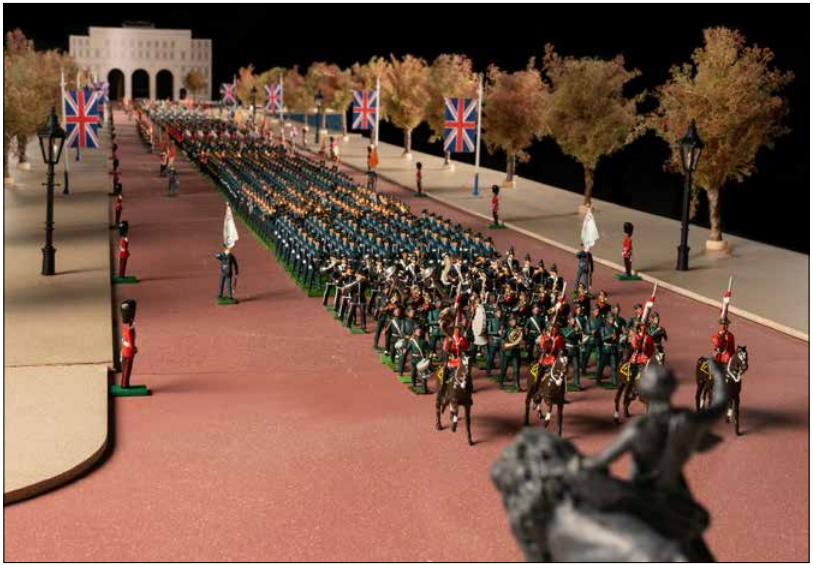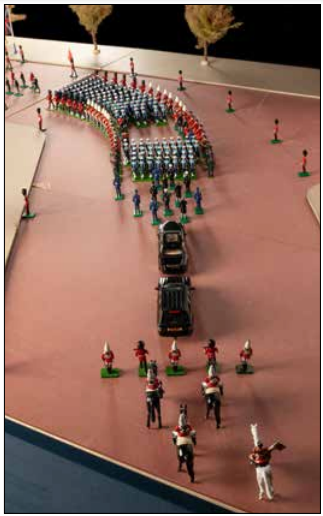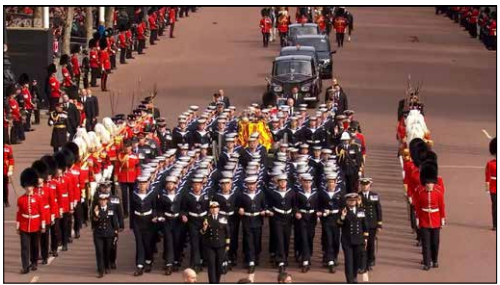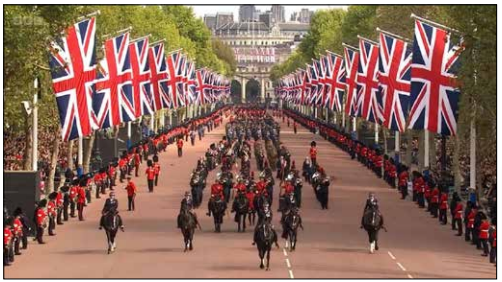Fans of the Netflix series The Crown may have spotted a few toy soldiers in the final episode of Season 6, ‘Sleep Dearie Sleep’. The scene involves Queen Elizabeth II (portrayed by Imelda Staunton) being presented with a scene depicting the funeral of her father George VI. In reality, this model had been put together to plan his funeral, with what was almost certainly Britains hollowcast figures, in the late 1940s early 1950s. In this particular scene, the Queen was being asked to face the rather daunting prospect of making decisions about her own funeral.
The figures used in the Crown’s depiction of this event were based on approximately 500 Britains modern toy soldiers, sourced by the Set Decorating Department, together with more custom designed
3D-printed figures painted by John Lee, Head of Model Making at the National Film & Television School. Specially commissioned architectural models of Buckingham Palace and Admiralty Arch, together with a simplified model of the Mall, with trees on the side providing a scenic backdrop. The centre piece of course is the gun carriage used to carry the coffin. Unfortunately, this is missing in Bonhams online photos shown here although it did form part of the lot.
Meticulously researched, the model is an accurate representation of the planned procession, produced especially for this scene in the last episode of the TV series. The model took between six to eight weeks to execute. It was made under the guidance of Major David RankinHunt, (fondly referred to by The Crown’s crew as “Major David”), The Crown’s Protocol Adviser. Stephen Daldry was the lead working with a team from Left Bank Pictures and the National Film & Television School (NFTS).
When it became clear that the Set Decorating Department would not be able to source and acquire enough soldier figures to accurately represent the vast funeral procession, they enlisted the help of BGI Supplies. Members of the Set Decorating team were dressed by the Costume Department before being life cast and scanned by the company for accurate 3D models to then be printed. Due to the short timeframe in which the models needed to be produced, once the figures had been printed they were passed to John Lee, who, alongside his team, painstakingly painted over 200 soldiers in the appropriate
ceremonial dress.


(unfortunately missing in this image!)

Family (the gun carriage is more obviously missing here) Another view of the cortege turning into the Mall, followed by limousines carrying the Royal Family (the gun carriage is more obviously missing here)
It took an entire day for around 10 people to install the model for filming in the Double Cube Room at Wilton House. While the width of the Mall, and its scale relative to the figures is correct, the length of the model had to be reduced in order for it to be accommodated in the building.
The final model is therefore a “one off” that can never be fully replicated. Having said that, most of the figures required can be put together from standard Britains figures if readers want to create their own version of this historic event.
The full procession was of course much larger, with over 5,000 personnel taking part, including cavalry and various other military units. The State Gun Carriage, used to transport the coffin, alone required 142 Sailors (98 to pull the carriage and the remainder acting as brakesmen).

and the immediate escort for the
Funeral of Queen Elizabeth II


